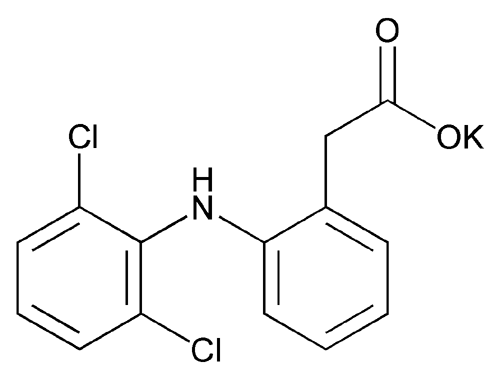Diclofenac Potassium
Benzeneacetic acid, 2-[(2,6-dichlorophenyl)amino]-, monopotassium salt.
Potassium [o-(2,6-dichloroanilino)phenyl]acetate
» Diclofenac Potassium contains not less than 99.0 percent and not more than 101.0 percent of C14H10Cl2KNO2, calculated on the dried basis.
Packaging and storage—
Preserve in light-resistant containers, and store at controlled room temperature.
Change to read:
Identification—
pH  791
791 :
between 7.0 and 8.5, in a 1% aqueous solution.
:
between 7.0 and 8.5, in a 1% aqueous solution.
Loss on drying  731
731 —
Dry it at 105
—
Dry it at 105 under vacuum for 3 hours: it loses not more than 0.5% of its weight.
under vacuum for 3 hours: it loses not more than 0.5% of its weight.
Heavy metals, Method II  231
231 :
not more than 10 ppm.
:
not more than 10 ppm.
Related compounds—
pH 2.5 Phosphate buffer—
Mix equal volumes of 0.01 M phosphoric acid and 0.01 M monobasic sodium phosphate. If necessary, adjust with additional portions of the appropriate components to a pH of 2.5 ± 0.2.
Mobile phase—
Prepare a filtered and degassed mixture of methanol and pH 2.5 Phosphate buffer (70:30). Make adjustments if necessary (see System Suitability under Chromatography  621
621 ).
).
Diluent—
Prepare a mixture of methanol and water (70:30).
Standard solution—
Prepare a solution of USP Diclofenac Related Compound A RS in methanol having a known concentration of about 0.25 mg per mL. Quantitatively dilute an accurately measured volume of this stock solution with Diluent to obtain a solution having a known concentration of about 1.5 µg per mL.
Resolution solution—
Prepare a solution in Diluent containing 40 µg per mL of diethyl phthalate, 0.5 mg per mL of USP Diclofenac Potassium RS, and 22.5 µg per mL of USP Diclofenac Related Compound A RS.
Test solution—
Transfer about 50 mg of Diclofenac Potassium, accurately weighed, to a 100-mL volumetric flask, dissolve in and dilute with Diluent to volume, and mix.
Chromatographic system (see Chromatography  621
621 )—
The liquid chromatograph is equipped with a 254-nm detector and a 4.6-mm × 25-cm column that contains packing L7. The flow rate is about 1.0 mL per minute. Chromatograph the Resolution solution, and record the peak responses as directed for Procedure: the relative retention times are about 0.5 for diethyl phthalate, 0.7 for diclofenac related compound A, and 1.0 for diclofenac potassium; and the resolution, R, between diethyl phthalate and diclofenac related compound A is not less than 4.0. Chromatograph the Standard solution, and record the peak responses as directed for Procedure: the relative standard deviation for replicate injections is not more than 5.0%.
)—
The liquid chromatograph is equipped with a 254-nm detector and a 4.6-mm × 25-cm column that contains packing L7. The flow rate is about 1.0 mL per minute. Chromatograph the Resolution solution, and record the peak responses as directed for Procedure: the relative retention times are about 0.5 for diethyl phthalate, 0.7 for diclofenac related compound A, and 1.0 for diclofenac potassium; and the resolution, R, between diethyl phthalate and diclofenac related compound A is not less than 4.0. Chromatograph the Standard solution, and record the peak responses as directed for Procedure: the relative standard deviation for replicate injections is not more than 5.0%.
Procedure—
Separately inject equal volumes (about 30 µL) of the Standard solution and the Test solution into the chromatograph, record the chromatograms, and measure the peak responses. Calculate the percentage of diclofenac related compound A in the portion of Diclofenac Potassium taken by the formula:
10(C/W)(rU / rS)
in which C is the concentration, in µg per mL, of USP Diclofenac Related Compound A RS in the Standard solution; W is the quantity, in mg, of Diclofenac Potassium taken to prepare the Test solution; and rU and rS are the diclofenac related compound A peak responses obtained from the Test solution and the Standard solution, respectively: not more than 0.1% of diclofenac related compound A is found. Calculate the percentage of each other impurity in the portion of Diclofenac Potassium taken by the formula:
10(C/W)(ri / rS)
in which ri is the individual peak response of each impurity obtained from the Test solution; and the other terms are as defined above: not more than 0.1% of each individual impurity is found, and not more than 0.3% of total impurities is found.
Assay—
Dissolve about 300 mg of Diclofenac Potassium, accurately weighed, in 50 mL of glacial acetic acid, and titrate with 0.1 N perchloric acid VS, determining the endpoint potentiometrically. Perform a blank determination, and make any necessary correction (see Titrimetry  541
541 ). Each mL of 0.1 N perchloric acid is equivalent to 33.424 mg of C14H10Cl2KNO2.
). Each mL of 0.1 N perchloric acid is equivalent to 33.424 mg of C14H10Cl2KNO2.
Auxiliary Information—
Please check for your question in the FAQs before contacting USP.
Chromatographic Column—
| Topic/Question | Contact | Expert Committee |
| Monograph | Clydewyn M. Anthony, Ph.D.
Scientist 1-301-816-8139 |
(MDCCA05) Monograph Development-Cough Cold and Analgesics |
| Reference Standards | Lili Wang, Technical Services Scientist 1-301-816-8129 RSTech@usp.org |
USP32–NF27 Page 2122
Pharmacopeial Forum: Volume No. 34(1) Page 87
Chromatographic columns text is not derived from, and not part of, USP 32 or NF 27.

